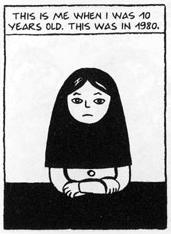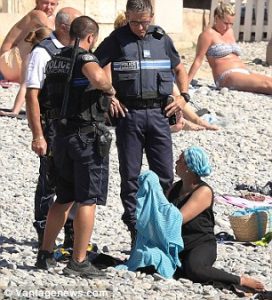Hello Readers,
My first blog post is inspired by a plot point in Marjane Satrapi’s Graphic Narrative Persepolis. The veil, whether in the form of a hijab, chador, burqa, or niqab, is a controversial subject that seems to be regulated by all the wrong people with all the wrong intentions.
In 1936, Reza Shah Pahlavi declared that all veils worn by Iranian women, including the chador, were to be banned, and encouraged the use of force to remove said veils from the heads of any woman who chose to wear one. There have been laws concerning female headscarves since Pre-Islamic times, allowing women of certain classes to wear the veil while prohibiting the practice by others. This time, however, the ban, which also included restrictions on traditional mens clothing, was based on an attempt at modernization and westernization. Of course some women had no desire to wear the veil, but many women who did were humiliated by having their coverings torn off by police, resulting in m any women choosing not to leave their house, and some committing suicide. Many wearer’s of the chador compared the ban to feeling naked.
any women choosing not to leave their house, and some committing suicide. Many wearer’s of the chador compared the ban to feeling naked.
During the Iranian Revolution, wearing a headscarf or chador became a revolutionary symbol. Even secular non-religious women wore it out of solidarity. Once the Revolution had succeeded in removing the Shah from power, things completely changed. Wearing a veil became the law in 1980. As seen in Marjane Satrapi’s Persepolis, young Marji, just ten years old after the Revolution, is required to wear a veil at her now girls-only religious school, while she and her classmates treat them like playthings.
I want to make my position clear, I am not against a woman deciding for herself to wear a headscarf or covering of any kind. The issue as I see it is that too often it is not the personal decision of the woman herself to determine what she does or does not wear. Any user of social media platforms such as Instagram or Facebook is most likely familiar with the “Free The Nipple” campaign, a protest concerning the censorships of women’s bodies on social media and the unequal treatment of female nudity by law enforcement.
Across the Atlantic Ocean, a related issue is currently in the spotlight. Several French cities have banned the wearing of the burkini (a swimsuit which covers the whole body except for the face, hands, and feet, in accordance with Islamic law). The official reasoning for the ban is for public security, a concern brought about by the numerous terrorist attacks that have plagued France throughout the year, but many see the ban as outright Islamophobia. A recent photograph depicting a woman o n a beach being forced to remove her burkini by several French police officers has gone viral. The image serves as visual metaphor for the actual issue at hand. A defenceless woman, enjoying herself at the beach, is surrounded by several heavily armed men who force her to undress in public.
n a beach being forced to remove her burkini by several French police officers has gone viral. The image serves as visual metaphor for the actual issue at hand. A defenceless woman, enjoying herself at the beach, is surrounded by several heavily armed men who force her to undress in public.
While almost all these laws that either enforce covering up or stripping down are claimed to be for the “protection” of women, they are never created or enforced by the women they are protecting.
Image #1: Illustrated by Marjane Satrapi for the book Persepolis, 2000, published by L’Association
Image #2: Courtesy of Vantagenews.com
F. Mirrazavi. (2013). The Removing of Hijab in Iran. Iran Review. Retrieved from: http://www.iranreview.org/content/Documents/The-Removing-of-Hijab-in-Iran.htm
L. Dearden. (2016). Burkini ban suspended: French court declares law forbidding swimwear worn by Muslim women ‘clearly illegal’. Independent. Retrieved from: http://www.independent.co.uk/news/world/europe/burkini-ban-french-france-court-suspends-rule-law-forbidding-swimwear-worn-muslim-women-seriously-a7211396.html